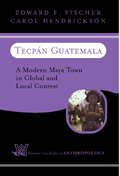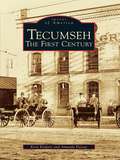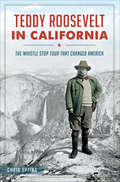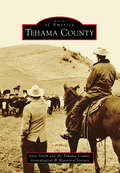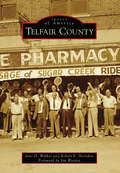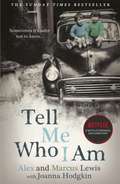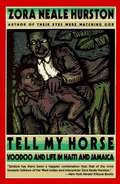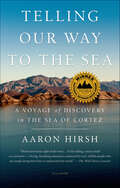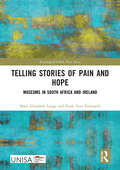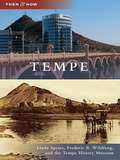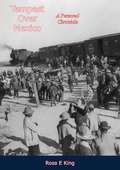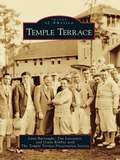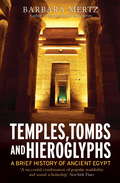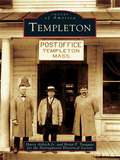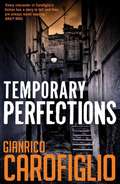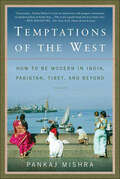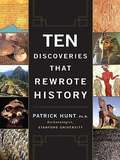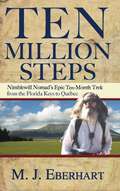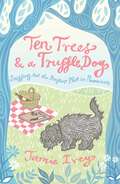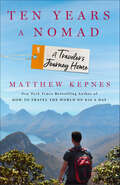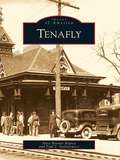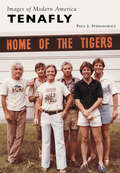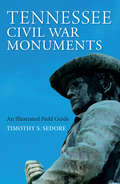- Table View
- List View
Tecpan Guatemala
by Edward F Fischer Carol HendricksonThis case study of a highland Guatemala town examines what it means to be Maya in a rapidly changing and globalized world. In providing an historical synopsis of the Kaqchikel Maya from pre-Columbian and Colonial times to the present day, this volume focuses on the dynamics of clutural boundaries in light of the use of the Kaqchikel language versus Spanish, the growing role of Protestantism and the revitalization of Maya religion versus Catholicism, and the effects of violent civil war on social networks. It examines the role of weaving and export agriculture in linking Tecpanecos to larger economic and political orbits and for defining local, regional, and national identities. As a result, this accessibly written book demonstrates that even seemingly traditional Maya cultural forms are actively constructed in the context of intense global connections.
Tecumseh: The First Century
by Amanda Payeur Kern KuipersTecumseh was founded by a family of pioneers. The principals in the venture were Musgrove Evans with his wife, Abi Evans (n©e Brown), Abi's brother, Joseph Brown, and Austin E. Wing, a cousin of the Brown family. Joseph and Abi had firsthand knowledge of pioneer life, having established Brownville in Jefferson County, New York, with their father, Jacob Brown. Austin E. Wing was already in Michigan, living in Monroe, and he convinced Musgrove that the new settlement would be a noble and profitable venture. Musgrove convinced his brother-in-law, Joseph, and the three formed a company with the purpose of purchasing land and founding a community in the interior of Michigan. Upon arrival, a number of the first settlers were taking lunch while building the first structure, a 20-by-20 footlog "company house" to be shared by all until they could each build their own houses , and Musgrove Evans suggested naming the town after the Shawnee chief Tecumseh. There was some debate, especially as Tecumseh had fought on the side of the British, but it was decided that he had truly fought for his convictions and for his people, so the name was decided upon.
Teddy Roosevelt in California: The Whistle Stop Tour That Changed America
by Chris EptingThe camping trip taken by the &“conservationist president&” that put America&’s national parks on the map—from the award-winning author of Roadside Baseball. During his whirlwind 1903 tour of the western states, President Theodore Roosevelt paid his first visit to California. In between the appearances and pageantry, he embarked on three days of epic adventure in the wilderness of Yosemite with the famous and influential naturalist John Muir. A lover of the rugged outdoors, Roosevelt was humbled and impressed by the camping trip, which proved to be one of the most important sojourns in presidential history. Through firsthand accounts, speeches and rare photographs, author Chris Epting tells the story of a great and profound journey that had a lasting effect on conservation history and the National Park System.
Tehama County: 150 Years Of Photos And History (Images of America)
by Josie Smith Tehama County Genealogical Historical SocietyTehama County--its name is a mystery but its sense of place is not. The county portrays a friendly Norman Rockwell-like America, with everything from May Day picnics and parades to fall harvests, rugged lumbermen, tough cowboys, and rodeo roundups. Carved out of three Northern California counties in 1856, Tehama County is largely rural, with fertile open spaces dominated by ranching and agriculture. To the east and west are lofty mountains and deep-set canyons sculpted by fast-moving streams to delight recreationists. These streams tumble into the mighty Sacramento River that courses through the middle of the county on its way to the Pacific Ocean. While rural, Tehama County has a rich and colorful heritage reflected in its people. Some of the more notable residents have included Ishi, a Yahi Indian considered the last of his people; William B. Ide, commander in chief of the brief Bear Flag Republic; and railroad magnate and governor of California, Leland Stanford, who built the largest vineyard and brandy distillery in the world here.
Telfair County
by Jim Wooten Jane H. Walker Robert E. HerndonCreek Indians inhabited land that was to become Telfair County. The early population was made up of settlers of Scottish descent. They had to produce almost everything they used, from food to equipment. Named for Edward Telfair, a two-term governor of Georgia, the county was formed in 1807 from a portion of Wilkinson County. Gradually, several counties were formed from parts of Telfair. Since 1870, Telfair County has kept its current boundaries. The original county seat was located in Jacksonville, about 20 miles south of McRae, Georgia, where it was moved by the legislature in 1871. While Georgia was a hotbed of secession, Telfair County representatives to the Secession Convention in 1861 voted "no" to the resolution, reflecting the sentiment of the county's population. Even though there was strong objection to secession, many Telfair County citizens did their duty and volunteered to serve the Southern cause.
Tell Me Something: What do you do when the life you always wanted disappears?
by Adele ParksIn this addictive novel, from the No. 1 Sunday Times bestselling author of Just My Luck, a marriage crumbles, cultures clash and love affairs begin in in glorious sun-drenched Italy.Don't miss Adele's gripping new novel, the Sunday Times bestseller Both of You, out now!Acclaim for Adele's compelling, twisty and acutely observed novels: 'Tightly plotted, brilliantly conceived and totally gripping' Lisa Jewell'Twisty, unputdownable and utterly engrossing' Jenny Colgan 'Brilliant storyline, great characters, very clever, loved it!' B A Paris 'Addictive and perceptive' Lucy AtkinsWILL THE ITALIAN DREAM BE WHAT SHE'S ALWAYS IMAGINED?Elizabeth has two goals in life. Once she fulfils the first - finding a sexy Italian husband - she thinks the second will come easy. But getting pregnant is proving difficult.So when the couple move to Italy for Roberto to run the family business, Elizabeth hopes the relaxing lifestyle will boost her chances of conceiving.But Italy is anything but peaceful...Elizabeth's wily mother-in-law seems to instantly hate her, Roberto's gorgeous ex is lingering a little too close for comfort... And. Still. No. Baby.Will Elizabeth's hunger for a bambino be enough to hold her marriage together? Or will she find herself dreaming of something else all together?What readers are saying about Tell Me Something:'The story is a rollercoaster ride full of ups and downsfor Elizabeth, and Parks' clever and unpredictable twists and turnsare thoroughly enjoyable' 'Elizabeth's character is highly developed and expertly portrayed. It's been a while since I read a book which made me laugh and cry simultaneously, for being both happy and sad'More praise for Adele Parks: Dark, funny and observant' Cosmopolitan 'Guaranteed to keep you hooked until the end' She magazine 'Deliciously down to earth' The Times 'Wonderfully absorbing' Stylist 'Will captivate you from the first page' Closer
Tell Me Something: What do you do when the life you always wanted disappears?
by Adele ParksIn this addictive novel, from the No. 1 Sunday Times bestselling author of Lies Lies Lies, a marriage crumbles, cultures clash and love affairs begin in in glorious sun-drenched Italy.Don't miss Adele's gripping new novel, the No. 1 bestseller Just My Luck, out now!Acclaim for Adele's compelling, twisty and acutely observed novels: 'Tightly plotted, brilliantly conceived and totally gripping' Lisa Jewell 'Twisty, unputdownable and utterly engrossing' Jenny Colgan 'Brilliant storyline, great characters, very clever, loved it!' B A Paris 'Addictive and perceptive' Lucy AtkinsWILL THE ITALIAN DREAM BE WHAT SHE'S ALWAYS IMAGINED?Elizabeth has two goals in life. Once she fulfils the first - finding a sexy Italian husband - she thinks the second will come easy. But getting pregnant is proving difficult.So when the couple move to Italy for Roberto to run the family business, Elizabeth hopes the relaxing lifestyle will boost her chances of conceiving.But Italy is anything but peaceful...Elizabeth's wily mother-in-law seems to instantly hate her, Roberto's gorgeous ex is lingering a little too close for comfort... And. Still. No. Baby.Will Elizabeth's hunger for a bambino be enough to hold her marriage together? Or will she find herself dreaming of something else all together?What readers are saying about Tell Me Something:'The story is a rollercoaster ride full of ups and downs for Elizabeth, and Parks' clever and unpredictable twists and turns are thoroughly enjoyable' 'Elizabeth's character is highly developed and expertly portrayed. It's been a while since I read a book which made me laugh and cry simultaneously, for being both happy and sad'More praise for Adele Parks: Dark, funny and observant' Cosmopolitan 'Guaranteed to keep you hooked until the end' She magazine 'Deliciously down to earth' The Times 'Wonderfully absorbing' Stylist 'Will captivate you from the first page' Closer
Tell Me Who I Am: The Story Behind the Netflix Documentary
by Joanna Hodgkin Alex And Marcus LewisThe story behind the hit Netflix documentary: The bestselling account of the bond between brothers and the shocking legacy of a dangerous mother.Imagine waking up one day to discover that you have forgotten everything about your life. Your only link with the past, your only hope for the future, is your identical twin.Now imagine, years later, discovering that your twin had not told you the whole truth about your childhood, your family, and the forces that had shaped you. Why the secrets? Why the silences? You have no choice but to begin again.This has been Alex's reality: a world where memories are just the stories people tell you, where fact and fiction are impossible to distinguish. With dogged courage he has spent years hunting for the truth about his hidden past and his remarkable family. His quest to understand his true identity has revealed shocking betrayals and a secret tragedy, extraordinary triumph over crippling adversity and, above all, redemption founded on brotherly love.Marcus his twin brother has sometimes been a reluctant companion on this journey, but for him too it has led to staggering revelations and ultimately the shedding of impossible burdens. Their story spans continents and eras, from 1950s debutantes and high society in the Home Counties to a remote island in the Pacific and 90s raves. Disturbing, funny, heart-breaking and affirming, Alex and Marcus's determination to rebuild their lives makes us look afresh at how we choose to tell our stories.
Tell My Horse: Voodoo and Life in Haiti and Jamaica
by Zora Neale HurstonAs a first-hand account of the weird mysteries and horrors of voodoo, Tell My Horse is an invaluable resource and fascinating guide. Based on Zora Neale Hurston's personal experiences in Haiti and Jamaica, where she participated as an initiate rather than just an observer of voodoo practices during her visits in the 1930s, this travelogue into a dark world paints a vividly authentic picture of ceremonies and customs and superstitions of great cultural interest.
Telling Our Way to the Sea: A Voyage of Discovery in the Sea of Cortez
by Aaron HirshA luminous and revelatory journey into the science of life and the depths of the human experienceBy turns epic and intimate, Telling Our Way to the Sea is both a staggering revelation of unraveling ecosystems and a profound meditation on our changing relationships with nature—and with one another.When the biologists Aaron Hirsh and Veronica Volny, along with their friend Graham Burnett, a historian of science, lead twelve college students to a remote fishing village on the Sea of Cortez, they come upon a bay of dazzling beauty and richness. But as the group pursues various threads of investigation—ecological and evolutionary studies of the sea, the desert, and their various species of animals and plants; the stories of local villagers; the journals of conquistadors and explorers—they recognize that the bay, spectacular and pristine though it seems, is but a ghost of what it once was. Life in the Sea of Cortez, they realize, has been reshaped by complex human ideas and decisions—the laws and economics of fishing, property, and water; the dreams of developers and the fantasies of tourists seeking the wild; even efforts to retrieve species from the brink of extinction—all of which have caused dramatic upheavals in the ecosystem. It is a painful realization, but the students discover a way forward. After weathering a hurricane and encountering a rare whale in its wake, they come to see that the bay's best chance of recovery may in fact reside in our own human stories, which can weave a compelling memory of the place. Glimpsing the intricate and ever-shifting web of human connections with the Sea of Cortez, the students comprehend anew their own place in the natural world—suspended between past and future, teetering between abundance and loss. The redemption in their difficult realization is that as they find their places in a profoundly altered environment, they also recognize their roles in the path ahead, and ultimately come to see one another, and themselves, in a new light.In Telling Our Way to the Sea, Hirsh's voice resounds with compassionate humanity, capturing the complex beauty of both the marine world he explores and the people he explores it with. Vibrantly alive with sensitivity and nuance, Telling Our Way to the Sea transcends its genre to become literature.
Telling Stories of Pain and Hope: Museums in South Africa and Ireland (ISSN)
by Ruth Teer-Tomaselli Mary Elizabeth LangeThe histories of South Africa and Ireland have been tumultuous and traumatic. Both countries have experienced political repression, sectarian violence and oppression that still impact the spiritual well-being of people today. Their parallel histories are of colonialism, displacement and division, and a fight for land and sovereignty. Both countries have embarked on a process of healing and reconciliation, yet there is an ongoing struggle for reparation and/or reversal of previous injustices.Recognising that museums of the 21st century have the potential to contribute to catharsis and mutual understanding, this book reflects on selected museums in South Africa and Ireland that commemorate the pain of the past and the hope for the future. The primary focus of the book is the way in which museum guides, curators and managers share their stories and the stories of their ancestors, and the stories of other people’s ancestors who were caught up in the conflict while interweaving the stories of the authors as well.Print edition not for sale in Sub Saharan Africa.
Tempe
by Frederic B. Wildfang Linda Spears Tempe History MuseumCharles Trumbull Hayden built the first canal on the south side of the Salt River in 1870. Soon after, he built a store, a flour mill, and a cable ferry across the river, and he started a town. Since then, Tempe has changed from a small farming community to a lively urban center. Moreover, Tempe's residential growth has made it the seventh-largest town in Arizona. Author Frederic B. Wildfang documents the history. Photographer Linda Spears illustrates the changes.
Tempest Over Mexico: A Personal Chronicle (American Imperialism)
by Rosa E KingHere is a set of memoirs by an English lady, who went to the resort city of Cuernavaca in Morelos in 1905. After the death of her husband...by 1910 she had purchased a tourist hotel and catered to the Mexican leaders of the day who frequently resorted to the beautiful southern city.Soon there came on the horrors of the revolution which Mrs. King clearly shows to have been a clash between the fundamental rights of man and intolerable exploitation by a class themselves most attractive as friends and acquaintances. The leader of the south, Zapata, is frankly ranked only after Hidalgo and Juarez in the social emancipation of Mexico. His personal foibles are not mentioned but the significance of his movement is constantly emphasized...There is no effort to portray the causes behind the political moves of the day. In fact, all politics are so carefully avoided that even the famous last trip of Madero to Cuernavaca is left with a queerly inadequate explanation. The high point of the narrative is the two chapters devoted to the siege of the southern city and the three covering its evacuation and the tragic journey of the people to Toluca. This account is stark and so unreal as to leave the reader almost skeptical were it not for a force and detail and a local description that bear the stamp of fact. Throughout, the author's theme is: "The Zapatistas were not an army; they were a people in arms". Though the immediate results were ruin, death, and destruction, the writer firmly believes the revolution justified and that "strong nations the world over have been built on the ruins of a just revolt".Now, thirty years later, the author, broken in health and with property gone, has retired to live in her beloved Cuernavaca, sincerely loving the humble and the great of her adopted country.In short: A book of memoirs by a competent observer; and withal one that is intensely interesting both to layman and scholar.-W. H. CALLCOTT
Temple Terrace (Images of America)
by 999 Lana Burroughs Grant Rimbey Tim LancasterThe influential and adventurous Chicago socialite Mrs. Potter Palmer (Bertha) struck out for Florida in 1910, eventually buying thousands of acres of land across the state. In 1914, after setting up residence in Sarasota, she established Riverhills, a hunting preserve on 19,000 acres in the area now known as Temple Terrace. Local historians believe it was Palmer's vision to create one of America's first planned golf course communities, where every Mediterranean Revival villa sold would include its own grove. Intended to provide a hobby and part-time income for the wealthy Northerners lured to the Sunshine State, 5,000 acres were planted with the exotic hybrid Temple orange--making up the largest citrus grove in the world at the time. The new city was named after the orange and for the sloping terrain of the land along the Hillsborough River.
Temples, Tombs and Hieroglyphs, A Brief History of Ancient Egypt: A Brief History Of Ancient Egypt (Brief Histories)
by Barbara MertzHave you ever wondered what it was like in the Valley of the Kings? To unlock the mysteries of the pyramids? Or sail down the Nile on Cleopatra's Barge? In her fascinating new introduction to the wonders of ancient Egypt expert Barbara Mertz tells the extraordinary history from the first stone age settlements to the age of Cleopatra and the Roman Emperors. It offers not just insights into the glories of the Pharaohs, but also intriguing glimpses of everyday life, folklore and culture.
Templeton
by Brian P. Tanguay Harry Aldrich Jr. Narragansett Historical SocietyThe villages of Templeton, originally called Narragansett, were founded in the mid-eighteenth century along the banks of the region's rivers and ponds. With adequate water power, agriculture and industry flourished, producing hay, corn, wool, paper, bricks, iron kitchenware, and all types of furniture. Templeton shares the history of the villages through the vintage photographs of Oren Williams and Wallace Underwood, two professional photographers who captured life there from the late 1800s to the early years of the twentieth century. Highlights include John Boynton, village tinsmith who founded Worcester Polytechnic Institute; the Templeton Hotel, which was destroyed by fire in 1888; and the Narragansett House, a popular destination for sleighing and school parties.
Temporary Perfections
by Antony Shugaar Gianrico CarofiglioThe fourth Guerrieri in the series. An investigation into the disappearance of a poor little rich girl in Southern Italy.
Temptations of the West: How to Be Modern in India, Pakistan, Tibet, and Beyond
by Pankaj MishraA vivid, often surprising account of South Asia today by the author of An End to SufferingIn his new book, Pankaj Mishra brings literary authority and political insight to bear on travels that are at once epic and personal. Traveling in the changing cultures of South Asia, Mishra sees the pressures—the temptations—of Western-style modernity and prosperity, and teases out the paradoxes of globalization. Avisit to Allahabad, birthplace of Jawaharlal Nehru, occasions a brief history of the tumultuous post-independence politics Nehru set in motion. In Kashmir, just after the brutal killing of thirtyfive Sikhs, Mishra sees Muslim guerrillas playing with Sikh village children while the media ponder a (largely irrelevant) visit by President Clinton. And in Tibet Mishra exquisitely parses the situation whereby the Chinese government—officially atheist and strongly opposed to a free Tibet—has discovered that Tibetan Buddhism can "be packaged and sold to tourists."Temptations of the West is a book concerned with history still in the making—essential reading about a conflicted and rapidly changing region.
Ten Discoveries That Rewrote History
by Patrick HuntThe world’s greatest archaeological finds and what they tell us about lost civilizations Renowned archaeologist Patrick Hunt brings his top ten list of ancient archaeological discoveries to life in this concise and captivating book. The Rosetta Stone, Troy, Nineveh's Assyrian Library, King Tut’s Tomb, Machu Picchu, Pompeii, the Dead Sea Scrolls, Thera, Olduvai Gorge, and the Tomb of 10,000 Warriors—Hunt reveals the fascinating stories of these amazing discoveries and explains the ways in which they added to our knowledge of human history and permanently altered our worldview. Part travel guide to the wonders of the world and part primer on ancient world history, Ten Discoveries That Rewrote History captures the awe and excitement of finding a lost window into ancient civilization. .
Ten Million Steps
by M. J. EberhartM. J. Eberhart, aka the Nimblewill Nomad, was a 60-year-old retired doctor in January 1998 when he set off on a foot journey that carried him 4,400 miles (twice the length of the Appalachian Trail) from the Florida Keys to the far north of Quebec. Written in a vivid journal style, the author unabashedly recounts the good (friendships with other hikers he met), the bad (sore legs, cutting winds and rain), and the godawful (those dispiriting doubts) aspects of his days of walking along what has since become known as the Eastern Continental Trail (ECT). An amazing tale of self-discovery and insight into the magic that reverberates from intense physical exertion and a high goal, Eberhart's is the only written account of a thru-hike along the ECT. Covering 16 states and 2 Canadian provinces, Ten Million Steps deftly mixes practical considerations of an almost unimaginable undertaking with the author's trademark humor and philosophical musings.
Ten Trees and a Truffle Dog: Sniffing Out the Perfect Plot in Provence
by Jamie IveyLeaving the London rat race behind, Jamie and his wife buy some land in Provence complete with a copse of truffle oaks. Their quest to find and train a truffle dog is as full of hidden discoveries as a truffle hunt itself. With delicious humour and storytelling, Ten Trees and a Truffle Dog will delight anyone who loves dogs, food and rural France.
Ten Years a Nomad: A Traveler's Journey Home
by Matthew KepnesPart memoir and part philosophical look at why we travel, filled with stories of Matt Kepnes' adventures abroad, an exploration of wanderlust and what it truly means to be a nomad.New York Times bestselling author of How to Travel the World on $50 a Day, Matthew Kepnes knows what it feels like to get the travel bug. After meeting some travelers on a trip to Thailand in 2005, he realized that living life meant more than simply meeting society's traditional milestones.Over 500,000 miles, 1,000 hostels, and 90 different countries later, Matt has compiled his favorite stories, experiences, and insights into this travel manifesto. Filled with the color and perspective that only hindsight and self-reflection can offer, these stories get to the real questions at the heart of wanderlust. Travel questions that transcend the basic "how-to," and plumb the depths of what drives us to travel — and what extended travel around the world can teach us about life, ourselves, and our place in the world.Ten Years a Nomad is a heartfelt comprehension of the insatiable craving for travel, unraveling the authenticity of being a vagabond, not for months but for a fulfilling decade.
Tenafly
by Paul J. Stefanowicz Alice Renner RigneyIn the mid-19th century, Tenafly was a small Dutch-settled farming community located along the Hudson River, west of the Palisades. Once the railroad started running through the village around 1860, Tenafly developed into an attractive growing neighborhood as well as a summer retreat for wealthy professionals. In 1894, the village broke away from Palisades Township and received borough status. The completion of the George Washington Bridge in 1931 made the journey to Manhattan more convenient, attracting more city dwellers as residents and cementing Tenafly's place in New York suburbia. Since the days of unpaved roads, handfuls of wood-framed stores, and country estates, Tenafly has boasted intimate parks and historic landmarks that give this picturesque Bergen County town its community feel. The photographs in Tenafly show the community's social and physical development throughout its more than 110-year history as a borough.
Tenafly (Images of Modern America)
by Paul J. StefanowiczTenafly has evolved from an Old Dutch farming community with unique estates owned by businessmen, mainly railroad executives, into a thriving New York suburb. The borough has long been known for its excellent school system. After the Second World War, development grew through technology that allowed for building on Tenafly’s hills, which enabled an affordable means of growth toward the Palisades. The area also increased in its desirability as a place for parents to raise children. As time passed, more opportunities became available for people of all ages to take part in recreation and school activities, enjoying the open spaces, parks, and town-wide events. Tenafly’s popular yet changing downtown, with its local shops and eateries, is where generations of school kids and adults have gathered to meet. The number of houses of worship has increased as diversity has been embraced by the community. Tenafly has developed as a town but boomed as a community with diverse interests and tastes.
Tennessee Civil War Monuments: An Illustrated Field Guide
by Timothy S. Sedore“A superb guide to 400 statues, columns, reliefs, and other components of the state’s commemorative landscape.” —Gary W. Gallagher, author of The Union WarThroughout Tennessee, Civil War monuments stand tall across the landscape, from Chattanooga to Memphis, and recall important events and figures within the Volunteer State’s military history. In Tennessee Civil War Monuments, Timothy S. Sedore reveals the state’s history-laden landscape through the lens of its many lasting monuments. War monuments have been cropping up since the beginning of the commemoration movement in 1863, and Tennessee is now home to four hundred memorials. Not only does Sedore provide commentary for every monument—its history and aesthetic panache—he also explores the relationships that Tennessee natives have with these historic landmarks.A detailed exploration of the monuments that enrich this Civil War landscape, Sedore’s Tennessee Civil War Monuments is a guide to Tennessee’s spirit and heritage.
